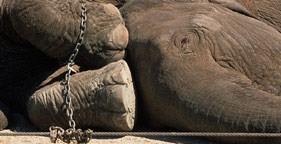CIRCUSES:
YOU CHOOSE...THEY CAN'T
![]()
![]()
![]()
![]()
![]()
![]()
![]()
"Sink that hook into ‘em ... when you hear that screaming then you know you got their attention. … Right here in the barn. You can’t do it on the road. … I’m not gonna touch her in front of a thousand people. … She’s gonna f---ing do what I want and that’s just f---ing the way it is."
—Elephant trainer Tim Frisco
 |
|
Click on the image above to view the undercover video (warning: explicit
language). RealPlayer required. |
Carson and Barnes: Undercover Video
Circus Life: No Life for Wild Animals: Circus Life- No Life for Wild Animals

|
|
| corbis |
The Humane Society of the United States opposes the use of wild animals in circuses and other traveling acts. Because cruelty to animals is inherent to such displays, we seek to end such uses of wild animals. We work to achieve this by increasing public awareness and strengthening the federal, state, and local laws that protect captive wild and exotic animals.
An Inhumane Existence Day after Day
Wild animals used in circuses and other traveling acts are routinely subjected to months on the road confined in small, barren cages. With few exceptions, they are provided with limited and inconsistent veterinary care. These animals often live in filthy and dilapidated enclosures or are chained in one position for the majority of the day with no chance to move, let alone express their full range of natural behaviors or to socialize with other members of their species. Their routine care is often entrusted to seasonal or temporary circus employees who have little or no experience caring for such animals.
How Do They Get Them to Do Those Tricks?
Despite claims to the contrary, trainers often use excessive and abusive training methods to establish and maintain the control necessary to make animals perform tricks. Although positive reinforcement is indeed part of a trainer's repertoire, it is by no means his or her only tool, and it is not enough to guarantee control of a four-ton elephant in the ring.
Regardless of training, the wild animals used in circuses behave instinctively and unpredictably. On August 20, 1994, at a Circus International matinee in Hawaii, an African elephant named Tyke crushed her trainer to death, injured another circus worker and 12 spectators, ran loose in the streets for 30 minutes, and was killed after being shot more than 80 times by police. Such incidents bring to light not only the suffering and stress endured by performing wild animals, but also the danger they can pose to circus workers and the public.
Who Protects Animals in the Circus?
The only federal legal protection for these animals is the Animal Welfare Act (AWA), which sets minimal standards for the handling, care, treatment, and transport of wild animals in circuses. AWA standards, enforced by the U.S. Department of Agriculture, are insufficient and inconsistently enforced. This combination of minimal standards and inadequate oversight permits circuses and traveling wild animal acts to keep wild animals in shocking conditions and still be in compliance with the AWA.
Furthermore, facilities that do not fully comply with the AWA are frequently given several chances to correct violations. Persistent violators have rarely faced federal prosecution or lost possession of animals. Even when local cruelty laws apply to circus animals, the nature of the legal system and the fact that circuses are constantly on the move can work against successful prosecution.
Some communities have addressed the problem of performing wild animals in circuses by prohibiting those circuses that use wild animals from operating within their jurisdictions.